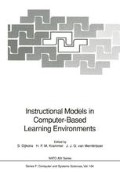Abstract
Decision-making plays a central role in computer-based learning environments as well as in computer-based instructional design environments. Therefore, it is also an explicit function of expert systems which are software products aimed at modeling the reasoning and decision-making of experts by explaining and making available human expert knowledge concerning performance of the particular task of instructional planning. This chapter will report the background and scope of the “prescriptive decision theory” (PDT) for expert systems in instructional design environments aimed at providing appropriate learning environments. In comparison with descriptive or normative decision theories, PDT involves interactive procedures aimed at revealing the preference structure of the decision-maker. Interactive procedures of decision-making are characterized by an interaction between subjective phases where the decision-maker has to offer local statements about his preference structure, and objective phases of calculation where the computer investigates alternative propositions based on available data. Exemplifying this procedure, a multiple-attribute-utility-test (MAUT) will be described of choosing media in the context of instructional design. With the help of this method it is possible to evaluate alternatives by taking into account the relative importance of individual goals and outcomes for the decision-maker, whereby each phase of the evaluation process is fully explicated. The significance of PDT and MAUT also will be discussed with regard to other relevant parts in the instruction design environments.
Access this chapter
Tax calculation will be finalised at checkout
Purchases are for personal use only
Preview
Unable to display preview. Download preview PDF.
References
Anderson, J.R.: The architecture of cognition. Cambridge, MA: Harvard University Press 1983
Coombs, C.H., Dawes, R.M., and Tversky, A.: Mathematical Psychology. Englewood Cliffs, NJ: Prentice Hall 1970
Dick, W., and Carey, L.: The systematic design of instruction. Tallahassee, FL: Harper Collins 1990
Dick, W., and Reiser, R.A.: Planning effective instruction. Englewood Cliffs, NJ: Prentice Hall 1989
Flechsig, K.H.: Einführung in CEDID. Ein Tätigkeitsunterstützendes und wissensbasiertes System für com¬puterergänztes didaktisches Design. Göttingen: CEDID GmbH 1990
Fletcher, J.D., Hawley, D.E., and Piele, P.K.: Costs, effects, and utility of microcomputer assisted instruction in the classroom. American Educational Research Journal. 27, (4), 783–806 (1990)
Houris, G.: The use of an instructional design model for increasing computer effectiveness. Educational Technology. 29, (1), 14–21 (1989)
Geoffrion, AM., Dyer, J.S., and Feinberg A.: An interactive approach for multicriterion optimization, with an application to the operation of an academic department. Management Science. 19, 357–368 (1972/73)
Georgeff,: Procedural control in production systems. Artificial Intelligence. 18, 175–201 (1982)
Mandl, H., Won, A., and Tergan, S.O.: Computer-based systems for open Learning. State of the art. Tübingen: DIFF 1990
Merrill, M.D.: An expert system for instructional design. IEEE Expert. 2, 25–37 (1987)
Merrill, M.D., Li, Z., and Jones, M.K.: Limitations of first generation instructional design. Educational Technology. 29, (1), 7–11 (1990)
Mylopoulos, J., and Levesque, H.: An overview of knowledge representations. In: On conceptual modelling: Perspectives from artificial intelligence, databases and programming languages. (M.L. Brodie, J. Mylopoulos and J.W. Schmidt, eds.). pp. 3–17. New York: Springer Verlag 1984
Pirolli, P.L., and Greeno, J.G.: The problem space of instructional design. In: Intelligent tutoring systems: Lessons learned. (J. Psotka, L.D. Massey and S.A. Mutter, eds.). pp. 181–201. Hillsdale, NJ: Lawrence Erlbaum 1988
Pirolli, P., and Russell, D.M.: The instructional design environment Technology to support design problem solving. Instructional Science. 19, 121–144 (1990)
Pfohl, H.C., and Braun, G.E.: Entscheidungstheorie: Normative and deskriptive Grundlagen des Entscheidens. Landsberg: Verlag Moderne Industrie 1981
Reigeluth, C.M.: Instructional design: What is it and why is it? In: Instructional design theories and models: An overview of their current status. (C.M. Reigeluth, ed.). pp. 3–36. Hillsdale, NJ: Lawrence Erlbaum 1983
Reiser, R.A., Dick, W.: Evaluating instructional software. Educational Technology: Research and Development. 38, (3), 43–50 (1990)
Reiser, R.A., and Gagné, R.M.: Selecting media for instruction. Englewood Cliffs, NJ: Educational Technology 1983
Russell, D.M., Moran, T.P., and Jordan, D.S.: The instructional design environment. In: Intelligent tutoring systems: Lessons learned. (J. Psotka, L.D. Massey and S.A. Mutter, eds.). pp. 203–228. Hillsdale, NJ: Lawrence Erlbaum 1988
Simon, H.A.: The sciences of the artificial. Cambridge, MA: MIT Press 1981
Stolurow, L.M.: Lernumwelten oder Gelegenheiten zum Nachdenken. In: Bedinungen des Bildungsprozesses. (W. Edelstein and D. Hopf, eds.). pp. 351–398. Stuttgart Klett 1973
Winn, W.: Instructional design and intelligent systems: Shifts in the designer’s decision-making role. Instructional Science. 16, 59–77 (1987)
Zionts, S., and Wallenius, J.: An interactive programming method for solving the multiple criteria problem. Management Science. 22, 652–663 (1975/76)
Author information
Authors and Affiliations
Editor information
Editors and Affiliations
Rights and permissions
Copyright information
© 1992 Springer-Verlag Berlin Heidelberg
About this paper
Cite this paper
Seel, N.M. (1992). The significance of prescriptive decision theory for instructional design expert systems. In: Dijkstra, S., Krammer, H.P.M., van Merriënboer, J.J.G. (eds) Instructional Models in Computer-Based Learning Environments. NATO ASI Series, vol 104. Springer, Berlin, Heidelberg. https://doi.org/10.1007/978-3-662-02840-7_4
Download citation
DOI: https://doi.org/10.1007/978-3-662-02840-7_4
Publisher Name: Springer, Berlin, Heidelberg
Print ISBN: 978-3-642-08148-4
Online ISBN: 978-3-662-02840-7
eBook Packages: Springer Book Archive

